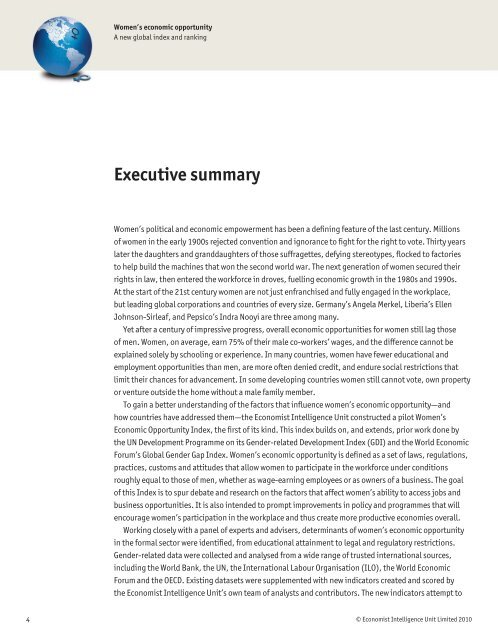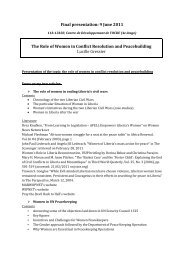Women's Economic Opportunity Index - Economist Intelligence Unit
Women's Economic Opportunity Index - Economist Intelligence Unit
Women's Economic Opportunity Index - Economist Intelligence Unit
- No tags were found...
Create successful ePaper yourself
Turn your PDF publications into a flip-book with our unique Google optimized e-Paper software.
Women’s economic opportunityA new global index and rankingExecutive summaryWomen’s political and economic empowerment has been a defining feature of the last century. Millionsof women in the early 1900s rejected convention and ignorance to fight for the right to vote. Thirty yearslater the daughters and granddaughters of those suffragettes, defying stereotypes, flocked to factoriesto help build the machines that won the second world war. The next generation of women secured theirrights in law, then entered the workforce in droves, fuelling economic growth in the 1980s and 1990s.At the start of the 21st century women are not just enfranchised and fully engaged in the workplace,but leading global corporations and countries of every size. Germany’s Angela Merkel, Liberia’s EllenJohnson-Sirleaf, and Pepsico’s Indra Nooyi are three among many.Yet after a century of impressive progress, overall economic opportunities for women still lag thoseof men. Women, on average, earn 75% of their male co-workers’ wages, and the difference cannot beexplained solely by schooling or experience. In many countries, women have fewer educational andemployment opportunities than men, are more often denied credit, and endure social restrictions thatlimit their chances for advancement. In some developing countries women still cannot vote, own propertyor venture outside the home without a male family member.To gain a better understanding of the factors that influence women’s economic opportunity—andhow countries have addressed them—the <strong>Economist</strong> <strong>Intelligence</strong> <strong>Unit</strong> constructed a pilot Women’s<strong>Economic</strong> <strong>Opportunity</strong> <strong>Index</strong>, the first of its kind. This index builds on, and extends, prior work done bythe UN Development Programme on its Gender-related Development <strong>Index</strong> (GDI) and the World <strong>Economic</strong>Forum’s Global Gender Gap <strong>Index</strong>. Women’s economic opportunity is defined as a set of laws, regulations,practices, customs and attitudes that allow women to participate in the workforce under conditionsroughly equal to those of men, whether as wage-earning employees or as owners of a business. The goalof this <strong>Index</strong> is to spur debate and research on the factors that affect women’s ability to access jobs andbusiness opportunities. It is also intended to prompt improvements in policy and programmes that willencourage women’s participation in the workplace and thus create more productive economies overall.Working closely with a panel of experts and advisers, determinants of women’s economic opportunityin the formal sector were identified, from educational attainment to legal and regulatory restrictions.Gender-related data were collected and analysed from a wide range of trusted international sources,including the World Bank, the UN, the International Labour Organisation (ILO), the World <strong>Economic</strong>Forum and the OECD. Existing datasets were supplemented with new indicators created and scored bythe <strong>Economist</strong> <strong>Intelligence</strong> <strong>Unit</strong>’s own team of analysts and contributors. The new indicators attempt to4© <strong>Economist</strong> <strong>Intelligence</strong> <strong>Unit</strong> Limited 2010




